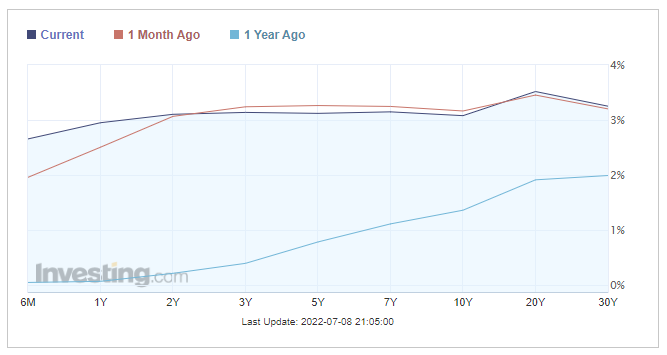- The MOVE Index measures Treasury rate volatility through options pricing
- Daily bond market swings are the wildest since the Global Financial Crisis
- Yield volatility and credit spreads are key risk indicators
An interesting theme is emerging among asset classes. Technicians constantly assess the environment with stocks, bonds, commodities, and currencies. Right now, intermaket analysis shows that stocks remain in a downtrend, while the fixed-income market might have found its footing after hitting a low in mid-June around that month’s Federal Reserve meeting. Commodities, meanwhile, have broken their uptrend as the U.S. dollar surges.
Monitoring MOVEs
Interest rate volatility, a measurement of daily swings in Treasuries, is at its highest since the Great Financial Crisis in 2009. The ICE BofAML MOVE Index closed last Friday at a whopping 145.25. On its own, that figure might not mean much to retail traders, but when plotted on a long-term chart, it illustrates just how wild the Treasury market (and bond market writ large) is right now.
MOVE Overview: Rate Vol Highest In 13 Years

Source: Investing.com
The best way to think about the MOVE Index is by comparing it to the S&P 500 volatility index, or VIX—only for fixed income. Currently, the yield curve is essentially flat from 2s to 30s, and yield spreads between corporate credit and Treasuries are wide.
Putting the MOVE Index to Use
Sure, it is an exciting market stat, but traders might wonder how to use the MOVE Index to assess financial conditions and risk.
Well, here’s how I look at it: Credit spreads remain wide, and the yield curve is inverted in some spots—all while the MOVE Index climbs. While falling off the highs from earlier in the month, bond market risk indicators appear to show bearish confluence for other risky assets. In short, we aren’t through the woods yet.
U.S. Treasury Yield Curve: Nearly Flat
Source: Investing.com
Credit Spreads: A Key Risk Gauge
While Treasuries might have put in a solid low last month, we need to see credit-risky bonds find a floor. As the second half of 2022 continues, I will closely watch how junk bonds perform along with beaten-down fixed-income markets like emerging market debt. Both sub-asset classes sport yields to maturity in the 8% to 9% range. When the MOVE Index spikes, that added volatility premium means risky bonds sometimes get priced lower, boosting yields.
A Higher MOVE Equals Costlier Mortgages, A More Strained Consumer
The MOVE Index also has vital implications for the domestic mortgage market. High rate vol makes a typical 30-year mortgage more costly as lenders price-up home loans. Historically, the spread between the average 30-year fixed-rate mortgage and the U.S. 10-year Treasury is about 1.9 percentage points. As of Friday, according to Mortgage News Daily and the U.S. Treasury, that difference stood at a massive 2.76%. More expensive home loans further strain an already unhappy consumer, potentially damaging future consumption.
The Bottom Line
Keep your eye on the MOVE Index and credit spreads. These are important indicators that might determine where stocks head. If rate volatility and yield spreads ease, that could further support an equity market rally.
Disclosure: I have no position in interest rate volatility instruments.

